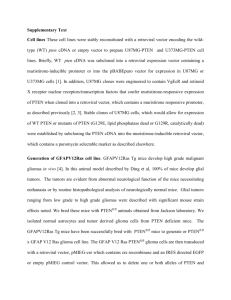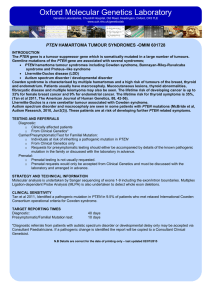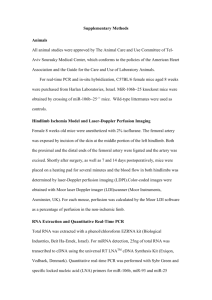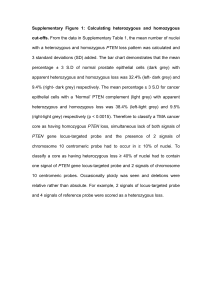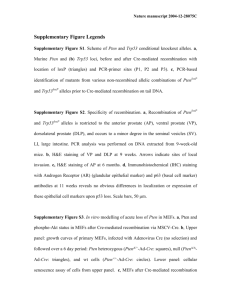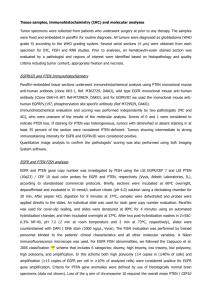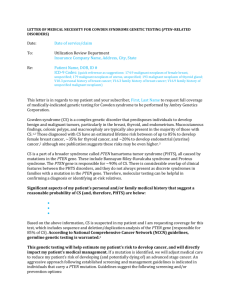Front. Biosc. 112739-2745 (2006).doc
advertisement
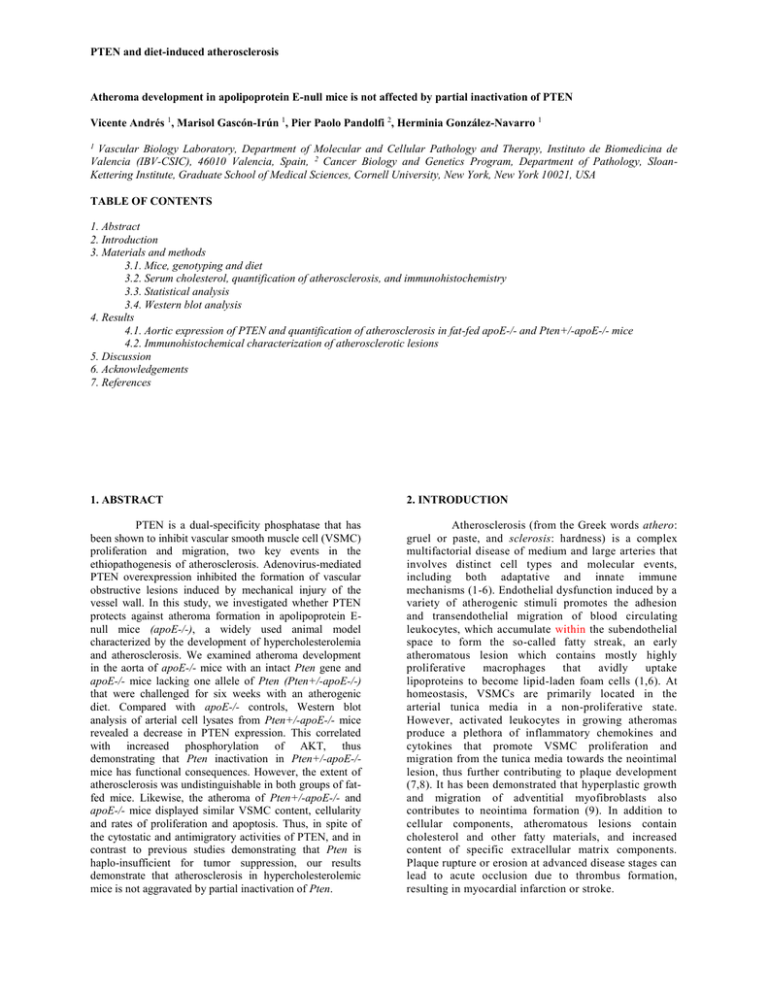
PTEN and diet-induced atherosclerosis Atheroma development in apolipoprotein E-null mice is not affected by partial inactivation of PTEN Vicente Andrés 1, Marisol Gascón-Irún 1, Pier Paolo Pandolfi 2, Herminia González-Navarro 1 1 Vascular Biology Laboratory, Department of Molecular and Cellular Pathology and Therapy, Instituto de Biomedicina de Valencia (IBV-CSIC), 46010 Valencia, Spain, 2 Cancer Biology and Genetics Program, Department of Pathology, SloanKettering Institute, Graduate School of Medical Sciences, Cornell University, New York, New York 10021, USA TABLE OF CONTENTS 1. Abstract 2. Introduction 3. Materials and methods 3.1. Mice, genotyping and diet 3.2. Serum cholesterol, quantification of atherosclerosis, and immunohistochemistry 3.3. Statistical analysis 3.4. Western blot analysis 4. Results 4.1. Aortic expression of PTEN and quantification of atherosclerosis in fat-fed apoE-/- and Pten+/-apoE-/- mice 4.2. Immunohistochemical characterization of atherosclerotic lesions 5. Discussion 6. Acknowledgements 7. References 1. ABSTRACT 2. INTRODUCTION PTEN is a dual-specificity phosphatase that has been shown to inhibit vascular smooth muscle cell (VSMC) proliferation and migration, two key events in the ethiopathogenesis of atherosclerosis. Adenovirus-mediated PTEN overexpression inhibited the formation of vascular obstructive lesions induced by mechanical injury of the vessel wall. In this study, we investigated whether PTEN protects against atheroma formation in apolipoprotein Enull mice (apoE-/-), a widely used animal model characterized by the development of hypercholesterolemia and atherosclerosis. We examined atheroma development in the aorta of apoE-/- mice with an intact Pten gene and apoE-/- mice lacking one allele of Pten (Pten+/-apoE-/-) that were challenged for six weeks with an atherogenic diet. Compared with apoE-/- controls, Western blot analysis of arterial cell lysates from Pten+/-apoE-/- mice revealed a decrease in PTEN expression. This correlated with increased phosphorylation of AKT, thus demonstrating that Pten inactivation in Pten+/-apoE-/mice has functional consequences. However, the extent of atherosclerosis was undistinguishable in both groups of fatfed mice. Likewise, the atheroma of Pten+/-apoE-/- and apoE-/- mice displayed similar VSMC content, cellularity and rates of proliferation and apoptosis. Thus, in spite of the cytostatic and antimigratory activities of PTEN, and in contrast to previous studies demonstrating that Pten is haplo-insufficient for tumor suppression, our results demonstrate that atherosclerosis in hypercholesterolemic mice is not aggravated by partial inactivation of Pten. Atherosclerosis (from the Greek words athero: gruel or paste, and sclerosis: hardness) is a complex multifactorial disease of medium and large arteries that involves distinct cell types and molecular events, including both adaptative and innate immune mechanisms (1-6). Endothelial dysfunction induced by a variety of atherogenic stimuli promotes the adhesion and transendothelial migration of blood circulating leukocytes, which accumulate within the subendothelial space to form the so-called fatty streak, an early atheromatous lesion which contains mostly highly proliferative macrophages that avidly uptake lipoproteins to become lipid-laden foam cells (1,6). At homeostasis, VSMCs are primarily located in the arterial tunica media in a non-proliferative state. However, activated leukocytes in growing atheromas produce a plethora of inflammatory chemokines and cytokines that promote VSMC proliferation and migration from the tunica media towards the neointimal lesion, thus further contributing to plaque development (7,8). It has been demonstrated that hyperplastic growth and migration of adventitial myofibroblasts also contributes to neointima formation (9). In addition to cellular components, atheromatous lesions contain cholesterol and other fatty materials, and increased content of specific extracellular matrix components. Plaque rupture or erosion at advanced disease stages can lead to acute occlusion due to thrombus formation, resulting in myocardial infarction or stroke. PTEN and diet-induced atherosclerosis Animal and human studies have identified signaling networks and factors that play a key role in the regulation of VSMC proliferation and migration in vitro and in vivo (7,8). The tumor suppressor PTEN is a dualspecificity lipid and protein phosphatase that negatively regulates the PI3K/AKT and FAK signaling pathways (1012). In addition to its role as tumor suppressor, mounting evidence strongly implicates PTEN in cardiovascular physiology and disease (13). PTEN can modulate cardiac myocyte hypertrophy and survival (14). Moreover, the PI3K/AKT pathway and PTEN are involved in the maintenance of endothelial cell (EC) and VSMC homeostasis (15-17). In vitro studies have shown that PTEN inhibits VSMC proliferation, migration and survival (18), and increased PTEN activity mediates perlecaninduced suppression of VSMC proliferation (19). In ECs, adenovirus-mediated overexpression of a dominant negative PTEN mutant enhanced VEGF-mediated cell survival, mitogenesis and migration, and these processes were strongly inhibited by overexpression of wild-type PTEN (20). Similarly, adenovirus-mediated expression of PTEN inhibited both basal and PDGF-mediated proliferation, migration and survival in VSMCs (18). More recently, it has been shown that PTEN induces G1 cell cycle arrest and inhibits MMP-9 expression via the regulation of NF-kappaB and AP-1 in VSMCs (21). In addition, adenovirus-mediated intraarterial delivery of PTEN inhibits neointimal hyperplasia and percent of stenosis in a rat model of balloon angioplasty (22). Finally, morpholino-mediated loss of endogenous PTEN induced a serum-independent growth phenotype in cultured serumdependent VSMCs, and decreased activity of PTEN was associated with high in vivo VSMC growth rates (23). aortic tissue and this correlated with augmented AKT phosphorylation compared to apoE-/- mice. However, atheroma size, VSMC content, cellularity and rates of proliferation and apoptosis were similar in both groups of mice. 3. MATERIALS AND METHODS 3.1. Mice, genotyping and diet apoE-/- mice (C57BL/6J, Charles River) and Pten+/- mice (29) (mixed 129/C57BL/6 genetic background) were mated and the double heterozygous F1 offspring were crossed with apoE-/- mice. The F2 offspring was genotyped by PCR analysis to identify Pten+/-apoE-/and apoE-/- mice and brother-sister mating of mice of these genotypes was performed to obtain the two experimental groups (apoE-/- and Pten+/-apoE-/- mice). After weaning, mice were maintained on a low-fat standard diet (2.8% fat, Panlab, Barcelona, Spain). At 2 months of age, mice received for 6 weeks an atherogenic diet containing 15.8% fat, 1.25% cholesterol and 0.5% sodium cholate (S4892S010, Ssniff, Germany). 3.2. Serum cholesterol, quantification of atherosclerosis, and immunohistochemistry Blood was withdrawn before, and after the high-fat diet to measure plasma cholesterol levels using enzymatic procedures (Sigma, St. Louis, Missouri). To determine the extent of atherosclerosis in the aortic arch region, fat-fed mice were killed and their aorta was fixed in situ with 4% paraformaldehyde. Tissue was extracted and fixation continued for approximately 24h. Specimens were paraffinembedded and mounted in a Microm microtome (Heidelberg, Germany) to quantify atherosclerosis essentially as previously described (30). Briefly, once the 3 valve cusps were reached, sections throughout the first ~2mm of the ascending aorta were discarded. Then, ~25 consecutive sections (4 m thickness) were taken from 2-3 regions of the aortic arch separated by ~60 m. Three cross-sections from each region were stained with hematoxylin/eosin. Images were captured with a Sony DKC-CM30 camera (Tokyo, Japan) mounted on a Zeiss Axiolab stereomicroscope and the area occupied by atherosclerotic lesions (intima) and the area of the media was determined by computer-assisted quantitative morphometry to determine the intima-to-media ratio using Sigma Scan Pro v5.0 (Jandel Scientific, San Rafael, California). Blood cholesterol and atheroma size were measured by a researcher who was blinded to genotype. The extent of atherosclerosis for each animal was calculated by averaging the values obtained in 2-3 independent aortic arch regions. Differences in lesion area between males and females were not significant, so data from both sexes were included in the analyses. Final Galley More recent investigations have also correlated increased levels of PTEN with decreased lesion development or VSMCs proliferation. Cholesterol-fed rabbits treated with propylthiouracil (PTU) (a drug with hypothyroid effect) showed a marked reduction in VSMC/macrophage ratio in atherosclerotic plaque, and addition of PTU to cultured rat VSMCs led to increased PTEN expression and reduced cell proliferation (24). It has been also suggested that PPARgamma-mediated transcriptional activation of PTEN by Rosiglitazone and Lovastatin might contribute to the therapeutic effects of these drugs (25). In view of the above results, we hypothesized that PTEN inactivation would enhance atheroma progression. To examine this possibility, we took advantage of the availability of the atherosclerosis-prone apoE-/- mouse (26,27), a widely used animal model that has allowed major advances in understanding the molecular basis of atherosclerosis (28). These mice spontaneously develop hypercholesterolemia and complex atherosclerotic lesions resembling to those observed in humans, a process that can be accelerated upon exposure to a high-fat cholesterol-rich diet. Since full inactivation of Pten causes embryonic lethality (29), the present study was designed to assess the effect of inactivating one allele of Pten on atherosclerosis in apoE-null mice. As expected, Pten+/apoE-/- mice exhibit reduction expression of PTEN in To quantify lesion cellularity, the number of cells per mm2 of plaque was determined by examining hematoxylin-stained arterial cross-sections. VSMCs were identified with alkaline phosphatase-conjugated antismooth muscle alpha-actin (SMalpha-actin) antibody (1/20, a-5691, Sigma). Alkaline phosphatase activity was detected with Fast Red (Sigma). VSMC content in atherosclerotic PTEN and diet-induced atherosclerosis Figure 1. Body weight and plasma cholesterol level in mice fed control chow or a cholesterol-rich diet. Data are shown as mean ± SEM of the indicated number of animals. Differences among groups were evaluated using ANOVA and Fisher’s PLSD post hoc test. There were no differences in the body weight between both genotypes. Regardless of the genotype for Pten, 2 and 6 weeks of fat feeding produced a statistically significant increase in plasma cholesterol versus prediet level (*, p<0.0001). No differences were observed between 2 and 6 weeks of fat feeding. lesions was determined morphometrically by dividing the SMalpha-actin-positive area by total plaque area. Apoptosis was measured using the ApopTag Peroxidase in situ Apoptosis Detection Kit according to the recommendations of the manufacturer (Serologicals Corporation, Norcross, GA). The enzymatic addition of deoxynucleotides to nicked ends of DNA was stopped with a Stop/Wash buffer, and the slides were incubated with the anti-digoxigenin conjugate. After incubation, slides were washed and then colour was developed by addition of the peroxidase substrate. Cell proliferation within atherosclerotic lesions was quantified using a monoclonal antibody against the proliferation marker Ki67 (clon SP6, Master Diagnostics). Before immunostaining, slides were boiled with 10 mM citrate buffer for 10 min for antigen retrieval and endogenous peroxidase was blocked with 0.3% H2O2. Detection was performed using a biotin-conjugated antirabbit secondary antibody and ABC kit system (Vectastin) using DAB as peroxidase substrate (Vector laboratories). Slides were counterstained with hematoxylin as before and immunoreactive cells per mm2 of atheroma were counted. Tris-HCl buffer (pH 7.5) containing 1% Triton X-100, 150mM NaCl, 1mM DTT and protease inhibitor Complete Mini cocktail (Roche, Mannheim, Germany) using an Ultraturrax T25 basic (IKA Labortechnik, Staufen, Germany). Western blot analysis was performed using the following primary antibodies: rabbit polyclonal anti-PTEN (1/500, NeoMarkers RB-072-PO), rabbit polyclonal antiphospho-Ser473-AKT (1/250, Cell Signalling 9271S), goat polyclonal anti-AKT (1/1000, Santa Cruz sc-1619) and mouse monoclonal anti-tubulin (1/100, Santa Cruz sc3035). Immunocomplexes were detected using an ECL detection kit according to the recommendations of the manufacturer (Amersham Biosciences). The relative intensity of protein bands was determined by densitometry. Final Galley 3.3. Statistical analysis Results are reported as mean SEM. In experiments with 2 groups, differences were evaluated using a 2-tail, unpaired Student t-test. Analyses involving more than 2 groups were done using ANOVA and Fisher’s post-hoc test (Statview, SAS institute, Cary, North Carolina). 3.4. Western blot analysis Snap-frozen arteries from three fat-fed mice of each genotype were pooled and lysed in ice-cold 50mM 4. RESULTS 4.1. Aortic expression of PTEN and quantification of atherosclerosis in fat-fed apoE-/- and Pten+/-apoE-/mice We intercrossed apoE-null mice and mice deficient for one allele of Pten to generate apoE-null mice with an intact Pten gene (apoE-/-) and with one allele of Pten disrupted (Pten+/-apoE-/-). After weaning, mice were maintained on a low-fat standard diet. At two months of age, blood was collected and mice were switched to a high-fat cholesterol-rich diet for six weeks. As shown in Figure 1A, body weight before the onset of the atherogenic diet and throughout fat-feeding was undistinguishable when comparing apoE-/- and Pten+/-apoE-/- mice. Likewise, fat-feeding caused similar level of hypercholesterolemia in both groups of PTEN and diet-induced atherosclerosis Figure 2. Expression of PTEN and AKT in the aorta of fat-fed apoE-/- and Pten+/-apoE-/- mice. Aortic lysates were subjected to Western blot analysis using the indicated antibodies. For AKT expression, we used antibodies directed against total AKT or AKT phosphorylated in Ser473. Relative protein abundance was estimated by densitometric analysis of two independent blots. Aortic PTEN expression in Pten+/-apoE-/- mice was reduced to 0.51 ± 0.02 versus the level in apoE-/- (set as 1, normalized by tubulin content). By contrary, the level of phosphorylated AKT in the aorta of Pten+/-apoE-/- mice was increased to 1.48 ± 0.06 as compared to the level in apoE-/- (set as 1, normalized by total AKT). Final Galley mice (Figure 1B). Because Pten inactivation has been shown to alter peripheral B lymphocyte fate (31), we analyzed by flow cytometry the presence of B-cells in the blood. These studies revealed similar B lymphocyte counts in apoE-/- and Pten+/-apoE-/- mice, both when analyzed before and after fatfeeding (data not shown). To assess whether partial genetic inactivation of Pten led to reduced aortic PTEN expression, we analyzed by Western blot aortic cell lysates. Densitometric analysis of two independent blots revealed an average ~50% decrease of PTEN protein expression in the aorta of Pten+/-apoE-/- as compared to apoE-/- mice (Figure 2). Importantly, the level of AKT phosphorylation, a parameter that is negatively regulated by PTEN (32), was increased in the aorta of Pten+/-apoE-/- mice (Figure 2), demonstrating that diminished PTEN expression in these mice has functional consequences. We next examined the extent of diet-induced atherosclerosis in aortic tissue. Consistent with numerous studies in apoE-/- mice, atherosclerosis prevailed within the aortic arch in both groups of mice. Thus, we quantified by computer-assisted planimetry the area of atheroma in aortic arch cross-sections stained with hematoxylin/eosin (Figure 3). This analysis disclosed no statistical differences in the intimato-media ratio when comparing apoE-/- and Pten+/-apoE-/mice (0.70 ± 0.09 and 0.64 ± 0.07, respectively; n=11, p>0.05). Collectively, these results demonstrate that reduced PTEN expression does not affect aortic atherosclerosis in fatfed hypercholesterolemic apoE-/- mice. 4.2. Immunohistochemical characterization of atherosclerotic lesions We next carried out immunohistochemical analysis to characterize the atheroma in fat-fed mice. Both the total number of cells per mm2 of atheroma (Figure 4A) and the area of atheroma occupied by VSMCs, as determined by SMalpha-actin immunoreactivity (Figure 4B), were statistically undistinguishable when comparing apoE-/- and Pten+/-apoE-/- mice (cellularity: 6168±637 versus 6971±806 cells per mm2 atheroma, respectively, p>0.05; VSMC content: 6±3 versus 4.7±0.9 SMalpha-actin-positive cells/mm2 atheroma, respectively, p>0.05). Similarly, the percentage of proliferating cells, as determined by Ki67 immunoreactivity (Figure 4C) and apoptotic cells, as determined by the Apoptag kit (Figure 4D), were comparable in the atheroma of both groups of PTEN and diet-induced atherosclerosis Figure 3. Reduced PTEN expression in the artery wall of Pten+/-apoE-/- does not affect the size of aortic atherosclerotic plaques. Mice with the indicated genotypes were challenged with a high-fat diet for six weeks. The graph represents the intimato-media ratio in cross-sections of the aortic arch, which did not show statistical differences between the two experimental groups (Student’s t-test, p>0.05). Representative examples of cross-sections stained with hematoxylin and eosin are shown at the bottom. The edge of the atherosclerotic plaque is drawn with a discontinuous line. Final Galley Figure 4. Immunohistochemical analysis of atherosclerotic lesions. Analysis was performed in cross-sections from the aortic arch and all parameters were quantified in the atheroma: lesion cellularity in hematoxylin-stained specimens (A), VSMC content as determined by SMalpha-actin immunoreactivity (B), proliferative cells as determined by Ki67 immunoreactivity (C), and apoptotic cells as revealed using the Apoptag kit (D). In all cases, differences between apoE-/- and Pten+/-apoE-/- mice were not statistically significant (Student’s t-test, p>0.05). PTEN and diet-induced atherosclerosis mice (Ki67-positive cells: 2.3±0.3% versus 3.5±0.5%, p>0.05; Apoptag-positive cells: 6.03±2.54% versus 7.26±2.31%, p>0.05, in apoE-/- and Pten+/-apoE-/- mice, respectively). 5. DISCUSSION Previous studies have conclusively demonstrated that PTEN inhibits VSMC proliferation and migration in vitro and reduces neointimal thickening in the rat carotid artery model of balloon angioplasty (18,19,21,22). To our knowledge, however, the role of PTEN on atheroma development has not been investigated. Therefore, we sought to examine the consequences of genetically inactivating Pten on diet-induced atherosclerosis using the apoE-null mouse model, a well characterized animal model of atherosclerosis that recapitulates important features of the human disease (26,27). Since global Pten inactivation in the mouse causes lethality during embryogenesis, (29) we analyzed fat-fed apoE-/- and Pten+/-apoE-/- mice. Inactivation of one allele of Pten led to a 50% reduction in PTEN protein expression in the aorta of Pten+/-apoE-/compared to apoE-/- mice. Importantly, PTEN inactivation had functional consequences, since phosphorylation of its target AKT/PKB in aortic tissue was increased by approximately 50% without changes in total AKT expression. However, we found no differences in aortic atherosclerotic lesion between apoE-/- and Pten+/-apoE-/mice. Likewise, analysis of the atheromatous lesions in these animals disclosed no differences in several histopathological parameters, including the area occupied by VSMCs, cellularity, proliferation and apoptosis. It has been previously shown that Pten+/- mice spontaneously developed germ cell, gonadostromal, thyroid and colon tumours (29), demonstrating that Pten is haploinsufficient for tumor suppression. Of note in this regard, adenovirus-mediated intraarterial delivery of Pten after balloon injury in the rat carotid artery inhibits neointimal lesion development (22), a pathological process characterized by abnormally high hyperplastic growth of VSMCs (7,33,34). Thus, alterations in PTEN expression have a major impact on the course of highly proliferative disorders, such as cancer and neointimal hyperplasia induced by mechanical injury of the vessel wall. In contrast, we show here that atheroma development in apoE-/- mice is not affected by partial inactivation of Pten. Although vascular cell hyperplasia is also a feature of atherosclerosis, this disease involves additional processes that might not be regulated by PTEN (e. g., arterial lipid accumulation, neointimal foam cell formation, abundant extracellular matrix formation by arterial cells, VSMC dedifferentiation) (1-6). On the other hand, Shen et al. have recently suggested that PTEN expression may contribute to cardiovascular diseases by causing p38 MAPK stress signal-induced inhibition of insulin-signaling and eNOS activation (35). Thus, alterations in PTEN expression may promote both pro- and anti-atherogenic effects. Finally, we cannot rule out the possibility that the 2-fold reduction in aortic PTEN expression in Pten+/-apoE-/- mice (cf. Figure 2) might not be sufficient to aggravate atheroma development compared to apoE-/- mice. Since global Pten inactivation causes embryonic lethality (29), addressing whether total Pten gene inactivation in the artery wall might indeed exacerbate atheroma progression will require the generation of apoE-/- mice with Pten disruption targeted to cell types known to participate in atherosclerosis (e. g., EC, VSMC, macrophage). 6. ACKNOWLEDGEMENTS We thank A. Díez-Juan for help with the generation of Pten+/-apoE-/- mice during the initial phases of this study, and M. J. Andrés-Manzano for the preparation of figures. This work was supported by grants from the Spanish Ministry of Education and Science and the European Regional Development Fund (SAF200403057), and from Instituto de Salud Carlos III (Red de Centros RECAVA, C03/01). H. G.-N. received salary support from the Spanish Ministry of Education and Science and the European Regional Development Fund (SAF2004-03057), and M. G.–I. from the Spanish Ministry of Science and Technology (FPU Program fellowship). 7. REFERENCES 1. Glass C. K. & J. L. Witztum: Atherosclerosis. the road ahead. Cell 104, 503-516 (2001) 2. Binder C. J., M. K. Chang, P. X. Shaw, Y. I. Miller, K. Hartvigsen, A. Dewan & J. L. Witztum: Innate and acquired immunity in atherogenesis. Nat Med 8, 1218-1226 (2002) 3. Greaves D. R. & K. M. Channon: Inflammation and immune responses in atherosclerosis. Trends Immunol 23, 535-541 (2002) 4. Lusis A. J.: Atherosclerosis. Nature 407, 233-241. (2000) 5. Ross R.: Atherosclerosis: an inflammatory disease. N Engl J Med 340, 115-126 (1999) 6. Libby P.: Inflammation in atherosclerosis. Nature 420, 868-874 (2002) 7. Andrés V.: Control of vascular cell proliferation and migration by cyclin-dependent kinase signalling: new perspectives and therapeutic potential. Cardiovasc Res 63, 11-21 (2004) 8. Dzau V. J., R. C. Braun-Dullaeus & D. G. Sedding: Vascular proliferation and atherosclerosis: new perspectives and therapeutic strategies. Nat Med 8, 1249-1256 (2002) 9. Sartore S., A. Chiavegato, E. Faggin, R. Franch, M. Puato, S. Ausoni & P. Pauletto: Contribution of adventitial fibroblasts to neointima formation and vascular remodeling: from innocent bystander to active participant. Circ Res 89, 1111-1121 (2001) 10. Wu X., K. Senechal, M. S. Neshat, Y. E. Whang & C. L. Sawyers: The PTEN/MMAC1 tumor suppressor phosphatase functions as a negative regulator of the phosphoinositide 3-kinase/Akt pathway. Proc Natl Acad Sci U S A 95, 15587-15591 (1998) 11. Tamura M., J. Gu, E. H. Danen, T. Takino, S. Miyamoto & K. M. Yamada: PTEN interactions with focal adhesion kinase and suppression of the extracellular matrix-dependent phosphatidylinositol 3-kinase/Akt cell survival pathway. J Biol Chem 274, 20693-20703 (1999) 12. Yamada K. M. & M. Araki: Tumor suppressor PTEN: modulator of cell signaling, growth, migration and apoptosis. J Cell Sci 114, 2375-2382 (2001) PTEN and diet-induced atherosclerosis 13. Oudit G. Y., H. Sun, B. G. Kerfant, M. A. Crackower, J. M. Penninger & P. H. Backx: The role of phosphoinositide3 kinase and PTEN in cardiovascular physiology and disease. J Mol Cell Cardiol 37, 449-471 (2004) 14. Schwartzbauer G. & J. Robbins: The tumor suppressor gene PTEN can regulate cardiac hypertrophy and survival. J Biol Chem 276, 35786-35793 (2001) 15. Dimmeler S. & A. M. Zeiher: PTEN-uating restenosis. Arterioscler Thromb Vasc Biol 22, 715-716 (2002) 16. Sata M. & R. Nagai: Phosphatidylinositol 3-kinase: a key regulator of vascular tone? Circ Res 91, 273-275 (2002) 17. Shiojima I. & K. Walsh: Role of Akt signaling in vascular homeostasis and angiogenesis. Circ Res 90, 12431250 (2002) 18. Huang J. & C. D. Kontos: Inhibition of vascular smooth muscle cell proliferation, migration, and survival by the tumor suppressor protein PTEN. Arterioscler Thromb Vasc Biol 22, 745-751 (2002) 19. Garl P. J., J. M. Wenzlau, H. A. Walker, J. M. Whitelock, M. Costell & M. C. Weiser-Evans: Perlecaninduced suppression of smooth muscle cell proliferation is mediated through increased activity of the tumor suppressor PTEN. Circ Res 94, 175-183 (2004) 20. Huang J. & C. D. Kontos: PTEN modulates vascular endothelial growth factor-mediated signaling and angiogenic effects. J Biol Chem 277, 10760-10766 (2002) 21. Moon S. K., H. M. Kim & C. H. Kim: PTEN induces G1 cell cycle arrest and inhibits MMP-9 expression via the regulation of NF-kappaB and AP-1 in vascular smooth muscle cells. Arch Biochem Biophys 421, 267-276 (2004) 22. Huang J., X. L. Niu, A. M. Pippen, B. H. Annex & C. D. Kontos: Adenovirus-mediated intraarterial delivery of PTEN inhibits neointimal hyperplasia. Arterioscler Thromb Vasc Biol 25, 354-358 (2005) 23. Mourani P. M., P. J. Garl, J. M. Wenzlau, T. C. Carpenter, K. R. Stenmark & M. C. Weiser-Evans: Unique, highly proliferative growth phenotype expressed by embryonic and neointimal smooth muscle cells is driven by constitutive Akt, mTOR, and p70S6K signaling and is actively repressed by PTEN. Circulation 109, 1299-1306 (2004) 24. Chen W. J., K. H. Lin, Y. J. Lai, S. H. Yang & J. H. Pang: Protective effect of propylthiouracil independent of its hypothyroid effect on atherogenesis in cholesterol-fed rabbits: PTEN induction and inhibition of vascular smooth muscle cell proliferation and migration. Circulation 110, 1313-1319 (2004) 25. Teresi R. E., C. W. Shaiu, C. S. Chen, V. K. Chatterjee, K. A. Waite & C. Eng: Increased PTEN expression due to transcriptional activation of PPARgamma by Lovastatin and Rosiglitazone. Int J Cancer (2006) 26. Plump A. S., J. D. Smith, T. Hayek, K. Aalto-Setala, A. Walsh, J. G. Verstuyft, E. M. Rubin & J. L. Breslow: Severe hypercholesterolemia and atherosclerosis in apolipoprotein E-deficient mice created by homologous recombination in ES cells. Cell 71, 343-353 (1992) 27. Zhang S. H., R. L. Reddick, J. A. Piedrahita & N. Maeda: Spontaneous hypercholesterolemia and arterial lesions in mice lacking apolipoprotein E. Science 258, 468471 (1992) 28. Meir K. S. & E. Leitersdorf: Atherosclerosis in the apolipoprotein E-deficient mouse: a decade of progress. Arterioscler Thromb Vasc Biol 24, 1006-1014 (2004) 29. Di Cristofano A., B. Pesce, C. Cordon-Cardo & P. P. Pandolfi: Pten is essential for embryonic development and tumour suppression. Nat Genet 19, 348-355 (1998) 30. Diez-Juan A. & V. Andres: The growth suppressor p27(Kip1) protects against diet-induced atherosclerosis. Faseb J 15, 1989-1995 (2001) 31. Anzelon A. N., H. Wu & R. C. Rickert: Pten inactivation alters peripheral B lymphocyte fate and reconstitutes CD19 function. Nat Immunol 4, 287-294 (2003) 32. Cantley L. C. & B. G. Neel: New insights into tumor suppression: PTEN suppresses tumor formation by restraining the phosphoinositide 3-kinase/AKT pathway. Proc Natl Acad Sci U S A 96, 4240-4245 (1999) 33. Clowes A. W., M. M. Clowes & M. A. Reidy: Kinetics of cellular proliferation after arterial injury. III. Endothelial and smooth muscle growth in chronically denuded vessels. Lab Invest 54, 295-303 (1986) 34. Clowes A., M. Reidy & M. Clowes: Kinetics of cellular proliferation after arterial injury. I: smooth muscle cell growth in the absence of endothelium. Lab Invest 49, 327333 (1983) 35. Shen Y. H., L. Zhang, Y. Gan, X. Wang, J. Wang, S. A. Lemaire, J. S. Coselli & X. L. Wang: Up-regulation of PTEN mediates p38 MAPK stress signal-induced inhibition of insulin signaling --- A cross-talk between stress signaling and insulin signaling in resistin-treated human endothelial cells. J Biol Chem (2006) Key Words: PTEN, Atherosclerosis, Hypercholesterolemia, apolipoprotein E, knock-out mice Final Galley Send correspondence to: Dr Vicente Andrés, Vascular Biology Laboratory, Department of Molecular and Cellular Pathology and Therapy, Instituto de Biomedicina de Valencia (IBV-CSIC), Jaime Roig 11, 46010 Valencia, Spain, Tel: 34963391752, Fax: 34963391751, E-mail: vandres@ibv.csic.es PTEN and diet-induced atherosclerosis DEAR AUTHOR: This is the final, professionally prepared, proof of your document. Figures and table placement will follow the guidelines provided below. Please note the following: CAUTIONARY NOTES ABOUT THE GALLEY talics, etc) and Greek letters may have been lost. Greek characters may not display properly by old browsers when the document is placed online. Please review the manuscript carefully and change Greek Characters to their English correlates, apply required formatting changes and manually number various sections of document without applying automatic numbering. Particularly, please insure that your name, affiliation, title and abstract are all free of any letters other than English characters. Letters such as "&" "$", "'" "ó" "ñ" "á" or "", "" ">", "±" etc in name, affiliation, title or abstract, must be converted to their English correlates. Please change these to their English correlates such as "o" "n" "a", "alpha", "beta" "more than" "+/-" . Non-English characters can not be entered into the XML files required for entry of the document into the PUBMED/MEDLINE databases. Please correct these in the title, name, affiliation and abstract at the beginning of the manuscript. In case that such characters are used, your name, title, etc might have blanks instead of the special characters used. name). This is required for inclusion of the manuscript in PubMed iting to fbs@bioscience.org. This is to prevent errors in the inclusion of the name or affiliation of authors in PubMed. Please note that Frontiers in Bioscience does not take responsibility for any error in the form or in PubMed entries. uction for revision of this galley is provided below. Revise and correct the enclosed formatted proof and save it as a Word document and not as a text or any other type of file. Please make all necessary corrections in this document and not any other document. Please do not send your changes and/or corrections to be made in an E-mail. Please do not make formatting changes such as changing the line spacing, removing or adding bold feature to titles etc, other than those permitted by FBS style. Please consult the formatting instruction for details on formatting documents at (http://www.bioscience.org/guides/format.pdf). All corrections should be made using the Word tracking option making the changes in colored font or by making corrections in red font. Other form of changes should not be made to this document. If you prefer to use the tracking option of "Word" for highlighting the changes, please make sure that you put the following statement at the end of the revised document: " Vendor: Please accept tracked changes". Please do not list corrections to be made at the end of the document without actually making the corrections. If you wish, instruct the vendor to make the changes by listing them at the end of document. In this case, vendor charges ($15/per correction) will apply. Please put the list of corrections to be made by the vendor at the end of the document. Mark it clearly as follows " Vendor: Please make the following changes:". Then, list the changes. For each change, please indicate the location including the page, column and paragraph number. At the end of the document, please verify that the changes made in red font in the text are OK (respond as "Changes OK" or "Changes Not OK" by referring to them at the end of the document). Following revision, please name the revised document as "revised.doc" and send the file as attachment to an E-mail. In a separate E-mail, indicate that the document is being sent so that if it is not delivered, you get notified. Figures and tables are placed in the same page where they are cited. If there is sufficient space, the figures and tables are placed in one or two column format in the same page where the figures and tables are cited. Otherwise, figures and tables are placed in the subsequent page(s). Figures and tables are placed in one column if the text is legible in printed document. Any special request for placement of figures will be charged by the vendor. the time of publication Final Galley end of document after the green line. If there are errors in placement of figures or tables or any other vendor error, please report these at the end of document for correction by vendor e publisher. By simply calling or writing to the publisher, you can easily obtain such permissions. It is required to mail a copy of permission to this office to be held along with your manuscript. APPROVAL Your submission of the final galley as revised.doc will be an indication that you have corrected and approve the final document for publication. PTEN and diet-induced atherosclerosis NOTE FOR CHANGES AFTER PUBLICATION NOTE: Subsequent to submission of this galley ·Only vendor generated errors will be corrected at no charge For non-vendor generated errors, there is a vendor charge of $295 for any correction to reprocess the manuscript. You may request a new galley for correction by writing to fbs@bioscience.org You will then receive another galley for making your corrections. FORM AND COMMENTS Please note changes in figures in order to conform them to the FBS style. Please note that the error bars in figure 4 were corrected since in some bars they were not showing the horizontal line. Please use tracking of the Word to make changes or use red font. You do not have to list changes made to the text at the end of the galley. Please review the manuscript very carefully before submitting it for publication After publication only vendor generated errors will be corrected at no charge Please do not make comments in the text. Place all your comments and changes below this line Notes to Vendor: PAGE 3: If possible, please move the heading “3.4. Western blot analysis” to top of right column. PAGE 4: Please, move below Figure 2 the text on top of left column (apoE-/- and Pten+/-apoE-/mice. Likewise, fat-feeding caused similar level of hypercholesterolemia in both groups of) PAGE 5: Please, move below Figure 3 and Figure 4 the text on top of left column (percentage of proliferating cells, as determined by Ki67 immunoreactivity (Figure 4C) and apoptotic cells, as determined by the Apoptag kit (Figure 4D), were comparable in the atheroma of both groups of) Final Galley PAGE 5-6: The legend of Figure 4 starts in page 5 and continues in page 6. Please, rearrange to have in the same page Figure 4 and the complete legend. PTEN and diet-induced atherosclerosis Final Galley
